What Do Lobsters Eat?
As an Amazon Associate I earn from qualifying purchases.
Lobsters are strange-looking crustaceans of the Nephropidae family. These animals are found on the seafloor and are prized seafood to humans. The Homarus and scampi lobsters are the most common lobsters for commercial use but there are also quite a few other species included in this family of sea animals.
As lobsters grow, they can change in color. Atypical colored lobsters that are not the usual brown or green color are usually donated to aquariums instead of eaten.
A healthy lobster can reach an age of 50 years in the wild and they can become much older when cared for in captivity.
What Do Lobsters Eat?
The diet of lobsters can vary based on their species. There are two main categories of lobster; the spiny lobster and the clawed lobster. Clawed lobsters are considered a ‘true’ lobster while spiny lobsters are considered ‘false’ lobsters. Here is a quick look at the most common foods these animals love to eat;
Clawed lobsters like the American lobster or Marine lobster love to catch and eat fish. They will sit quietly and wait for small fish and fry to pass by. The lobster will catch the fish with its claws using lightning-fast movements. They will catch and eat any type of fish they can get their claws into but typically focus on small fish.
Mollusks
American lobsters and Caribbean spiny lobsters both eat mollusks. These are invertebrate sea animals that include species like octopus, scallops, snails, squids, oysters, clams, and others. There are 85,000 species of mollusks. Lobsters love to eat a huge variety of these animal types that dwell on sea beds and lobsters will eat any of them they can find.
Crustaceans
American lobsters and spiny lobsters also love to eat crustaceans. These are hard-shelled arthropod animals like crabs, lobsters, crayfish, shrimps, prawns, krill, woodlice, and barnacles. Lobsters eat a great variety of these types of animals.
Algae and other plants
American and European lobsters both enjoy eating algae. Since lobsters tend to dwell on the seafloor, they usually focus on algae that grow in these locations. There is a huge variety of these aquatic organisms and lobsters do eat most types.
Some lobsters do also eat other types of sea plants like zooplankton and flowering plant species.
Worms and sea urchins
Sea plants are a good food source for European lobsters and Caribbean spiny lobsters. Lobsters will eat all sorts of marine worm types such as flatworms, roundworms, segmented worms, arrow worms, Arcon worms, and horseshoe worms.
Spiny lobsters love to eat sea urchins. They will eat a variety of sea urchin types that they can find living on the sea bed.
Shrimps
Caribbean furry lobsters mostly eat shrimps. Other lobsters like spiny lobsters and American lobsters will also eat shrimp but furry lobsters mainly focus on this food source.
Carrion meat
Lobsters will eat almost anything they find. Most of them, and especially the spiny lobster, will feed on carrion meat they find drifting about the sea bed. They will eat just about any carrion meat they can get their claws on.
Diet Variations
Lobsters are omnivores and therefore will have quite a few diet variations. One of the strangest things about their diet is that they can become cannibalistic. They will eat other lobster species and even their own young if other foods are not available to them or if the other lobster is small enough to catch and devour.
How to Feed Lobsters
Lobsters use smell and taste senses to hunt for foods. They use their small antennae to locate their prey and will then catch their prey using their claws. Lobsters will also use their front legs to sift through sand while looking for carrion meat or other prey.
What Do Lobsters Eat In The Wild?
In the wild, these animals can only eat food they find in their natural habitat. They are omnivores and as such will eat just about any food they find drifting or swimming about the ocean or sea bed.
What Do Lobsters eat in Captivity?
In captivity, lobsters are fed healthy balanced meals that include various foods such as fish, crabs, clams, worms, and sea urchins. They are much more likely to become cannibalistic in captivity out of boredom or due to the lack of natural foods.
What do Baby Lobsters Eat?
Baby lobsters are called crickets or chickens depending on their size. They can eat all the same foods as their parents but in smaller sizes. Some baby lobsters will even adopt the ‘surf and eat’ approach to survive. In this method, the baby lobster will grab onto a jellyfish and ‘surf’ it while eating the jellyfish.
How Much Do Lobsters Eat?
Different species and sizes of lobsters can eat different amounts of food. They also eat more when they are losing their old shells because they need to replenish lots of calcium. After molting their old shells, lobsters may even try to eat their old shells to help them harden their new shells faster.
A baby lobster will take about four days to consume an 8cm jellyfish. Since they can eat carrion meat, you don’t have to worry about removing old food from the tank. Just don’t feed lobsters to a point where the water becomes dirty.
How Often Do Lobsters Eat?
Lobsters will continuously look for food throughout the day. They tend to eat often and for as long as the food is available to them. They can also change their diet in times of need. Typically, they prefer to eat at night and will hide from predators during the day.
Do Humans Eat Lobsters?
Humans do eat lobster and consider this food as a delicacy. The bigger the lobster is, the more you can expect to pay for the meal. You can also catch lobsters yourself if you have the right permits in place or if you are fishing in the correct locations. Lobsters are however very challenging to catch since they live on the sea bed.
Amazon and the Amazon logo are trademarks of Amazon.com, Inc, or its affiliates.
What Do Lobsters Eat: Lobster Diet by Species & Habitat
Lobsters are a type of crustacean, which is a group of animals that have jointed legs and a hard shell. Other types of crustaceans include crabs, shrimp, crawfish and krill. Lobsters differ from these other creatures because they have longer tails and claws compared to their bodies.
They have long bodies with muscular tails, and live in crevices or burrows on the sea floor. Three of their five pairs of legs have claws, including the first pair, which are usually much larger than the others; they use these for defense and to tear apart prey. They also used the two front ones as antennae.
In the wild, lobsters typically live for around 20 years. Someone harvest commercially and consider them a delicacy.
Lobsters are omnivorous and mainly eat mollusks, crustaceans, and fish. They scavenge food from the sea floor, but will also hunt for prey items. Some larger specimens have taken down small sharks!
This article will explore how lobster diets can vary, depending on their habitat and species. Lobster food preferences also depend on the time of year and other factors like water temperature, salinity, depth, etc. Depending on these factors, lobsters may be scavengers (eating many dead animals) or herbivores (eating only plants). Typically though, they are primarily carnivorous creatures that consume fish carcasses and smaller crustaceans like shrimp and krill.
The Basics of Lobster Diet
Lobsters are primarily predators, eating clams, mussels, crabs and other crustaceans. They also eat fish when they are readily available in the environment. Lobsters use their hard claws to crush or tear apart prey that they have caught, then bring their food into their mouths where it is further crushed with the sharp edges of the lobster’s teeth before being swallowed.
This method of eating is slow and labor-intensive, but it allows the lobster to consume prey that is much larger than themselves. Some lobsters have also scavenged on dead fish or other animals that have died in their vicinity. Lobstermen sometimes find lobsters with stomachs full of sand, which the lobster has eaten to extract the organic matter in it.
Some lobsters are more opportunistic feeders, scavenging on whatever food they can find. These types of lobsters are found in habitats where there is not a lot of larger prey for them to eat, like sea grass beds or eelgrass meadows.
Editor’s note: When lobsters can’t find any of the typical food sources, they’ll eat plants and algae. When food is scarce, lobsters can go several months without eating and still be fine.
What Do Lobsters Eat: Lobster Diet by Species & Habitat
Different species have different lobster diets depending on their habitat and species.
Lobsters that live in the deep sea near hydrothermal vents are scavengers, eating dead animals like fish or crabs that sink into these areas from other parts of the ocean.
The diet and behavior also changes for lobsters living in different habitats throughout their life cycle.
- Juvenile lobsters may scavenge for food on the sea floor, but as it matures, it will become more predatory and hunt live prey.
- Lobsters that live in estuaries (a place where a river empties into the ocean) typically eat mostly small crabs, shrimp and other crustaceans. But, if there is a large influx of fish into the estuary, these lobsters will also eat fish.
- Lobsters that live in salt marshes (a type of coastal wetland) typically have a diet that consists mostly of marsh plants and small crabs.
The diets of lobsters can vary depending on the season. Lobsters are cold blooded creatures so during certain times of the year, they eat more or less depending on how hot or cold it is. This means that their diet can vary from season to season as well.
Let’s see these diets more in depth.
1. European Lobster
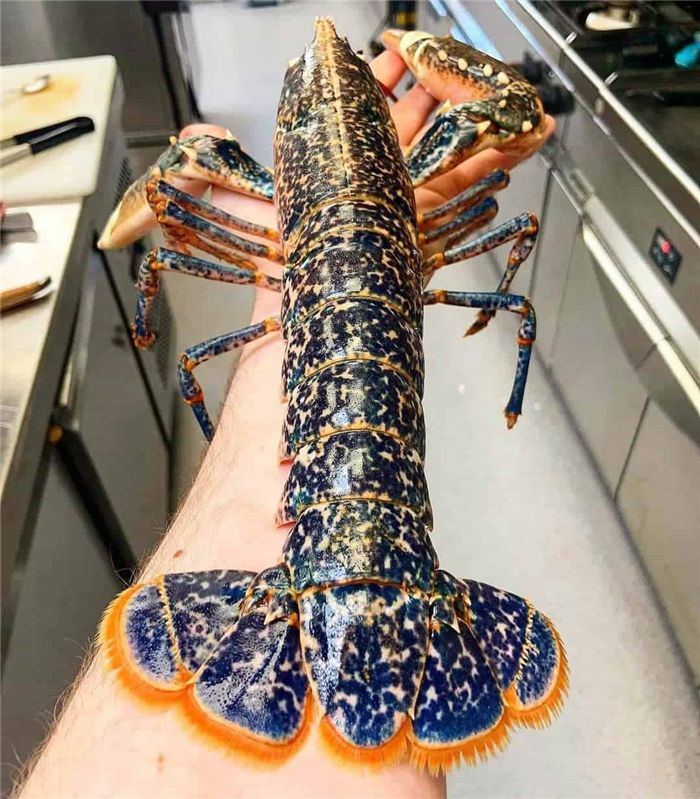
The European lobster is a species that lives in the waters around Europe, North Africa and parts of Asia.
They come in many colors, typically being brown, green or reddish. They are the species that are most commonly consumed as a food source around the world.
They have been known to mainly eat fish and mollusks like mussels in their natural environment, but they will also eat crustaceans occasionally.
In the summer, when lobsters are younger, they eat a lot of small marine animals like crabs or prawns, but as they get older, their diet becomes more varied with larger fish being consumed too.
2. American Lobster
The American lobster is the species that most people are familiar with. This species of lobster look very similar to the European lobster, but it has a few distinct features.
The first being that its claws are much smaller than those of the European Lobster, with each claw weighing around 70g on average whereas in Europe they can be up to 100g per claw. They also have fewer teeth, which means their bites are less powerful.
The American lobster is found in the North Atlantic Ocean, from Labrador to Georges Bank and on the continental shelf of Europe. They typically eat small crabs, clams, mussels and other crustaceans, but they have also been known to scavenge on dead animals that sink to the bottom of the ocean.
It lives in North America and can be found along the east coast of Canada and down to parts of Florida.
The American lobster is a carnivorous creature that typically eats smaller animals like clams, crabs and mussels when it is in its younger stages of life. But as an adult, this species normally feeds on herring, hake, flounder, cod and other fish.
The American lobster will also scavenge on dead animals that have sunk to the bottom of the ocean floor. Lobsters typically avoid eating other lobsters, but there have been cases where they will eat them if they are available.
3. Spiny Lobster
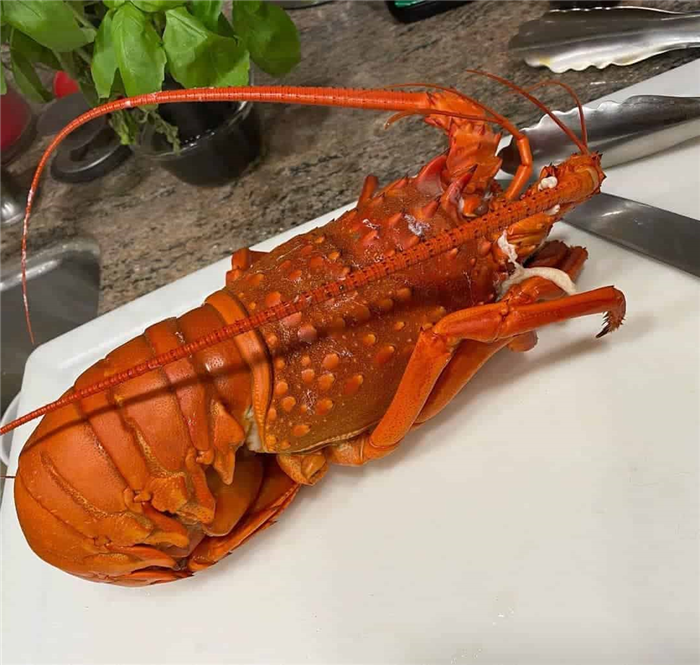
The spiny lobster is a species of lobster that lives in the tropical and subtropical waters around the world. Their name comes from the fact that they have spines running down the length of their back.
This species is a scavenger and eats mostly dead animals that are on the sea floor but they will also eat small fish or crustaceans if they are available.
The spiny lobster has eaten other lobsters, although this is not common. Its diet depends on their habitat as well as what time of year it is.
It is mainly a scavenger and has eaten dead animals like fish or crabs that have fallen into its environment. They can travel up to 160 meters (525 feet) in search of food.
4. Japanese Spider Crab
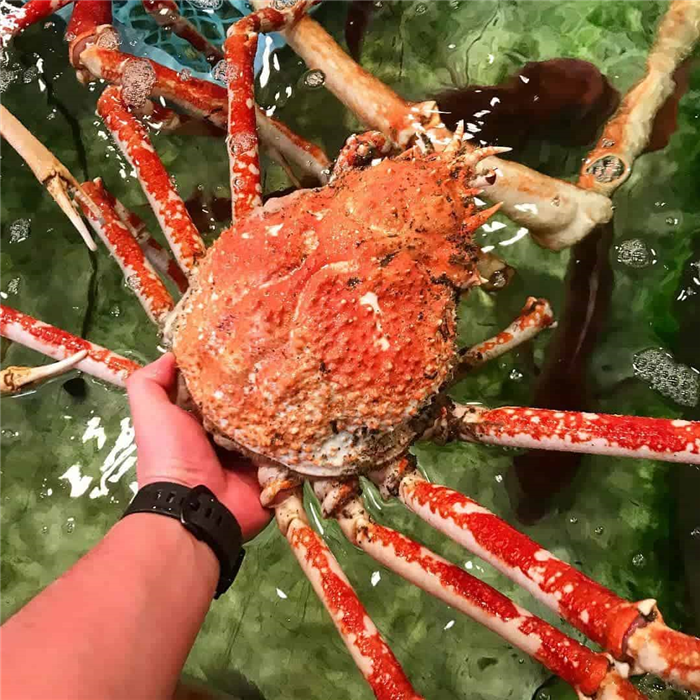
The Japanese spider crab is a species of marine crab that lives in the waters around Japan. It’s huge, as you can see from the pic. It can grow to be 12 feet across and weigh 44 pounds.
This species is considered to be a scavenger, and its diet mainly comprises other dead animals like fish or crabs. Japanese spider crabs have eaten other types of lobsters though so they are not above cannibalism either!
When these creatures get older, their diets become more varied and they will eat things like worms, sea urchins or even other crabs.
5. Rock Lobster
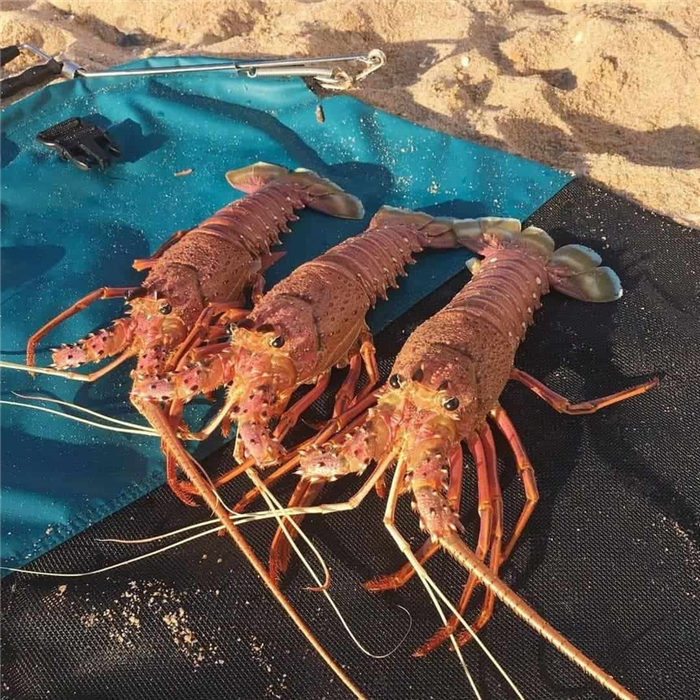
Rock lobsters are a type of lobster that is found in the waters around New Zealand and Australia.
They are scavengers, eating anything they can find, including dead animals that have sunk to the bottom of the ocean floor. Rock lobsters also eat crabs, shellfish and fish when these items are available for them to consume.
Editor’s note: this is just a tiny list of the main lobster families found across the world. But in reality, there are over 80 different species of lobsters. Their diets are all similar to the ones in this list.
Variations in Diet
Lobsters are cold-blooded creatures, meaning they cannot regulate their own body temperature. This means that lobsters change their diet depending on the season because during certain times of the year they need to eat more or less depending on how hot or cold it is.
Let’s look at the American Lobster as an example.
In winter, lobsters eat less because it is cold and they need to conserve their energy for staying warm. Their eating process consumes a lot of energy.
In spring, there are a lot of small organisms that spawn off into the water which makes food more plentiful, so these young adult lobsters will eat a lot during this time.
In summer, lobsters eat less because they become more active and their metabolism (the rate at which the body converts food into energy) speeds up. They will also be in a breeding stage during this time, so they are focused on mating rather than eating.
What about Baby Lobsters?
Lobster babies are called “larvae” and it takes about seven to ten years for them to become full grown adults. During this time, they will change habitats many times until they find the perfect one that works best for their species.
The American lobster larvae is known as a phyllosome, which means it lives in its burrow and it feeds on phytoplankton, which is a type of microscopic algae.
The lobster larvae will feed until winter, when food becomes scarce, so they have to rely on their energy reserves from before summer. These reserves are called “fatty tissue” and this process is known as “molting”.
Lobster larvae have no predators because other marine animals cannot get into their burrows.
The lobster’s diet is mainly what the species has adapted to eat over many years of evolution. Every species will adapt differently depending on its habitat and competition for food.
Lobsters in Captivity
There are many species of lobsters that can be kept in captivity. The main thing to remember is that the diet they will require depends on what type of lobster it actually is.
Lobster tanks need to have at least one hiding place for your new pet because these creatures like their own personal space and territory. It’s also important to have a variety of different sized rocks in the tank for them to climb on and hide under.
Lobsters like to eat things that are easy to find, so it’s important to keep their tank clean and free of any dead animals or plant life. You can also feed your lobster frozen seafood like shrimp, crab meat or fish.
Lobster Feeding Behavior
When it is feeding time for a lobster, they will typically spread out their antennae (a feeler on the head of a crustacean) and extend their claws to sense what is around them.
They will then move towards whatever they are going to eat by walking or swimming. Lobsters use their claws to tear apart food items and suck the insides out.
They have teeth in their stomachs that grind the food up so they can digest it properly. Which means they don’t chew their food like humans do. Instead, they will swallow it whole and let these teeth in their stomachs grind the meat up.
Lobsters usually eat at night since that is when they are the most active. They spend the day hiding from predators.
Lobsters also cannot see very well, which is why they use their antennae to feel around them when it’s time for a meal. They will often eat with other lobsters in the same environment, too.
They are usually pretty quiet during feeding times and don’t make any noise, but sometimes you can hear them eating if there is a large group and they are very close by.
Conclusion
Lobsters’ diet is very important for their survival and the overall health of the species. It can affect how they behave, where they migrate to during certain seasons and so on.
We’ve only covered a few types of lobsters, but there are over 80 species found all over the world. It’s just that their diet doesn’t vary that much between the different species. So we only picked the most common ones. You won’t see a lobster sad about eating mollusks or other crustaceans.
Lobsters are omnivores which mean they eat both plants and animals. Often, their diet is determined by what food sources are available in their habitat. Their feeding behavior depends on what kind of lobster it is (adult or larva) as well as how old that individual animal is.
The different food that a lobster will consume can vary depending on the species, but they mostly eat small invertebrates such as crabs, clams and mussels. They also eat fish, worms and other sea creatures. Lobsters are not picky with their diet. Hungry animals (including humans) can’t afford to be.
What Do Lobsters Eat?
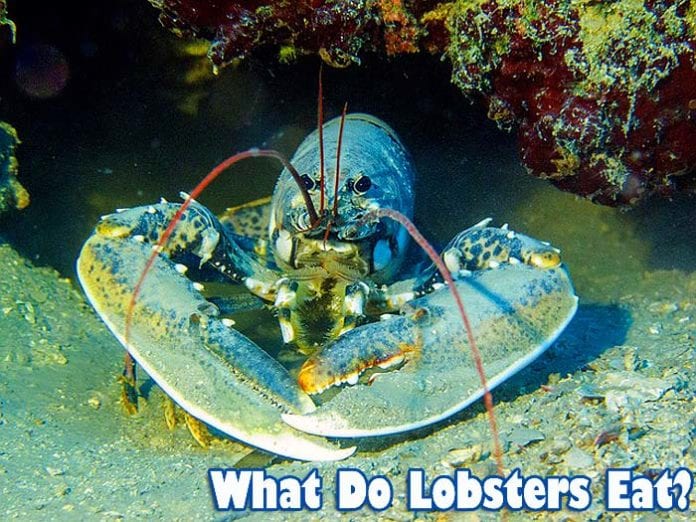
What Do Lobsters Eat? Lobsters are invertebrates classified as crustaceans. They are commonly found in shallow ocean waters. During the day, lobsters hide in rock crevices. Lobsters are considered to be opportunists when it comes to feeding.
In general, lobsters consume an omnivorous diet which constitutes of fish, other crustaceans, worms, and some plants.
Table of Contents
What Do Lobsters Eat?
| Type of Lobster | Diet |
|---|---|
| American Lobster | Fish, mollusk members, crustaceans, algae, and some plants. |
| European Lobster | Crabs, worms, urchins, starfish, algae, and zooplankton. |
| Caribbean Spiny Lobster | Macroalgae, mollusks, marine worms, other crustaceans, echinoderms, detritus, marine invertebrates, sea urchins, and carrion. |
| Caribbean Furry Lobster | Shrimps |
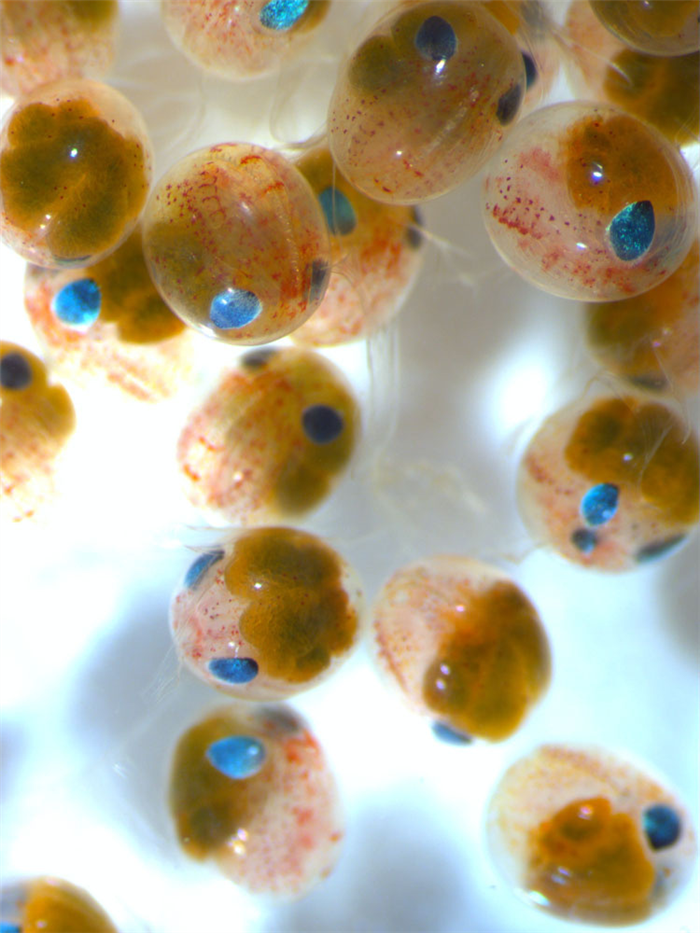
Lobsters Diet by Types
Different lobster species exist. These organisms are divided into 2 groups, namely clawed and spiny lobsters. Clawed lobsters are considered to be the true lobsters while the spiny lobsters are false lobsters.
Types of lobsters that will be covered in this section will be examples of the 2 broader groups identified earlier.
What Do American Lobsters Eat?
| Kingdom | Order | Family | Genus | Species |
|---|---|---|---|---|
| Animalia | Decapoda | Nephropidae | Homarus | Homarus americanus |
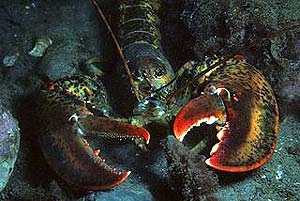
American lobster primarily consumes fish, mollusk members, crustaceans, algae, and some plants.
- The American lobster makes up the first half of the clawed lobsters. The American lobster can reach a length of 1.1 m, and its weight can go to about 20 kg.
- This large-bodied crustacean is also referred to as the Maine lobster. As its name suggests, this lobster has a wide distribution in North America (the Atlantic coast).
- The American lobster inhabits temperate marine waters. They can also be found in muddy and sandy regions, but they prefer areas with rocks (rocky reefs) because they provide a safe hiding haven for them.
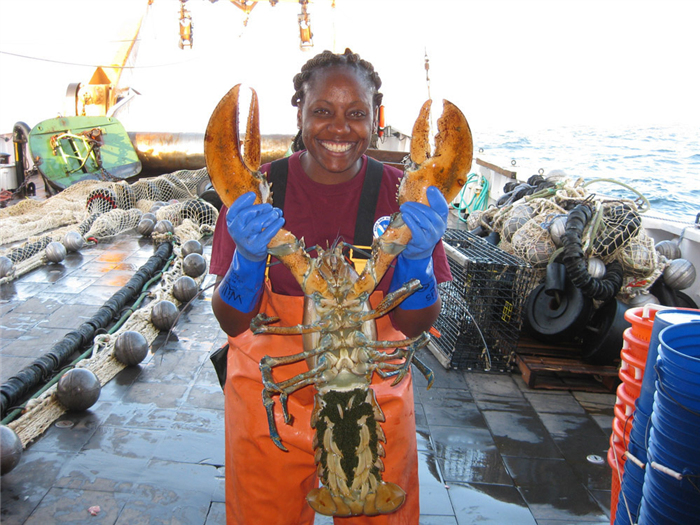
What Do European Lobsters Eat?
| Kingdom | Order | Family | Genus | Species |
|---|---|---|---|---|
| Animalia | Decapoda | Nephropidae | Homarus | Homarus gammarus |
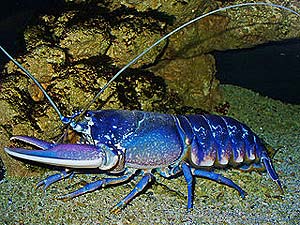
European lobster diet constitutes of benthic organisms like crabs, worms, urchins, starfish, algae, and zooplankton.
- This lobster is the other half of the clawed lobster category. As its name suggests, the European lobster is commonly found along the European coast.
- This lobster is notable for its dark blue hue with cream/yellow spots on the top and yellow color at the bottom.
- This lobster inhabits the continental shelf in depths of up to 150 m.
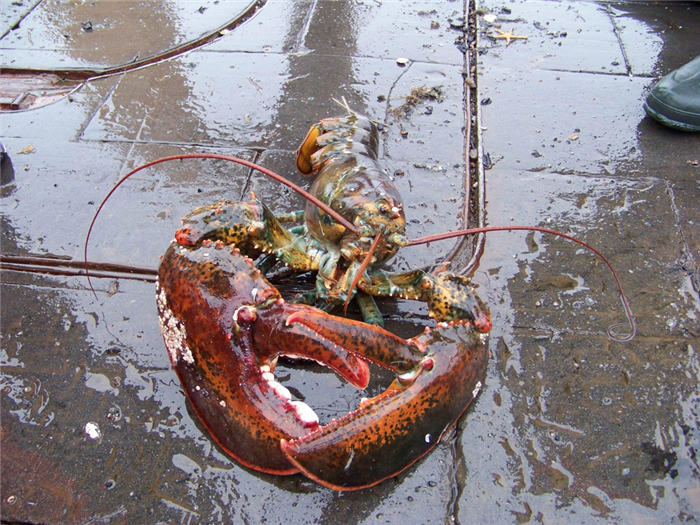
What Do Caribbean Spiny Lobsters Eat?
| Kingdom | Order | Family | Genus | Species |
|---|---|---|---|---|
| Animalia | Decapoda | Palinuridae | Panulirus | Panulirus argus |
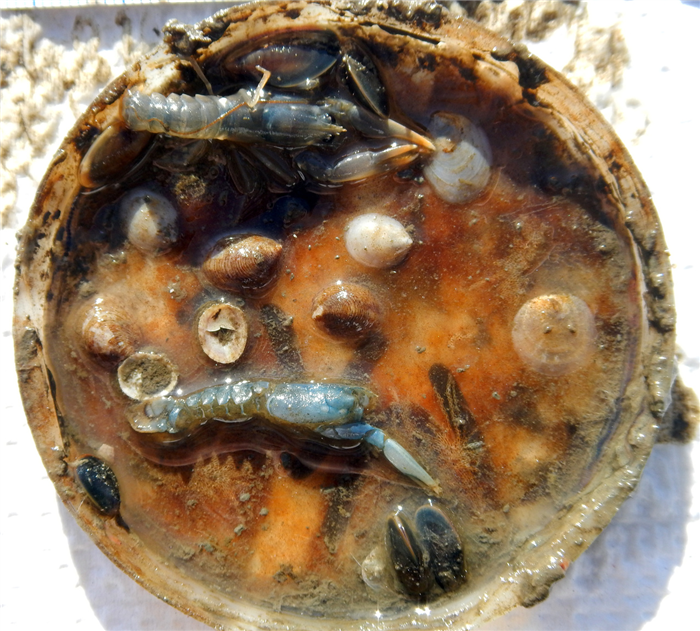
Caribbean spiny lobster feeds on plants like the macroalgae, mollusks, marine worms, other crustaceans, echinoderms, detritus, and an array of marine invertebrates, sea urchins, and carrion.
- The Caribbean spiny lobster is the largest crustacean notable in the Caribbean Sea and the adjacent waters.
- These organisms are benthic meaning they live at the bottom of the ocean, to depths of up to 90 m. Their habitat regions include temperate or tropical marine waters.
- Adult Caribbean spiny lobsters can be found offshore, especially next to rocks, coral reefs, and eelgrass beds.
What Do Caribbean Furry Lobsters Eat?
| Kingdom | Order | Family | Genus | Species |
|---|---|---|---|---|
| Animalia | Decapoda | Synaxidae | Palinurellus | Palinurellus gundlachi |
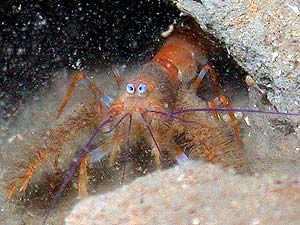
Caribbean furry lobster feeds on a carnivorous diet consisting of shrimps.
- This lobster’s pincers are coated with hair-like strands giving it a furry appearance.
- This lobster is commonly found in marine waters, especially next to rocks and coral reefs.
How Do Lobsters Hunt?
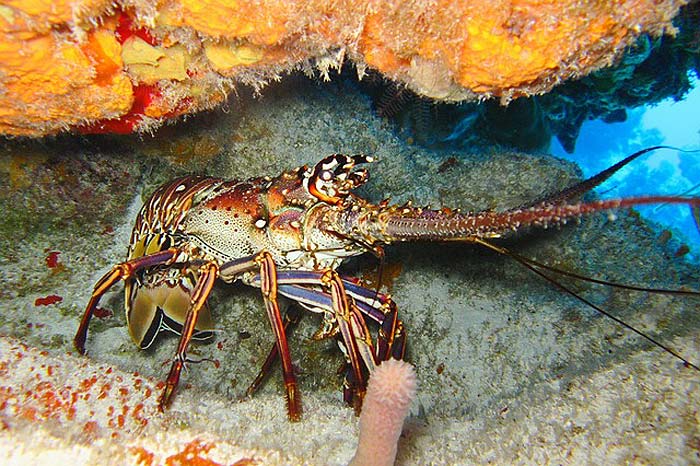
For lobsters, hunting is facilitated by their senses (smell and taste).
- They first locate their victim using the small antennae located on the front part of their heads. Their front legs come in handy for lobsters during hunting.
- They use their front feet to sift sand on the ocean to find their prey.
- They then direct their prey to their claws which are used for crushing.
When Do Lobsters Eat?
Lobsters are nocturnal.
- Lobsters tend to be active at night and so they will always be found cruising at the ocean’s shoreline in search of food when night falls.
- During the day they hide from predators.
How Often Do Lobsters Eat?
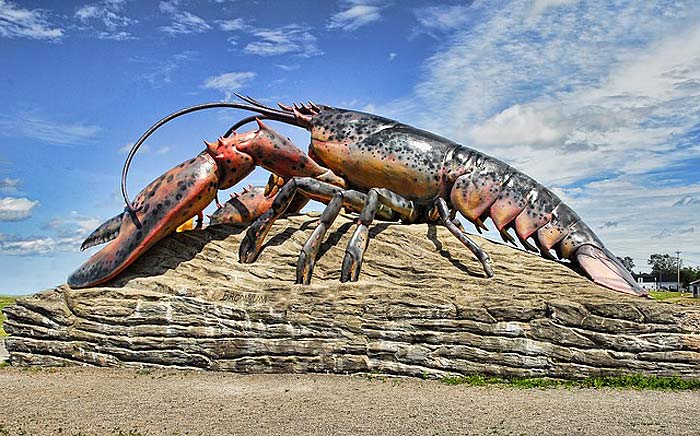
Lobsters will tend to eat as often as long as the food is available and as long as their claws can reach.
- In the event of scarcity, especially during spring, they change their diet.
- During this time, they eat plants and sponges to meet their daily energy requirement.
What Eats Lobsters?
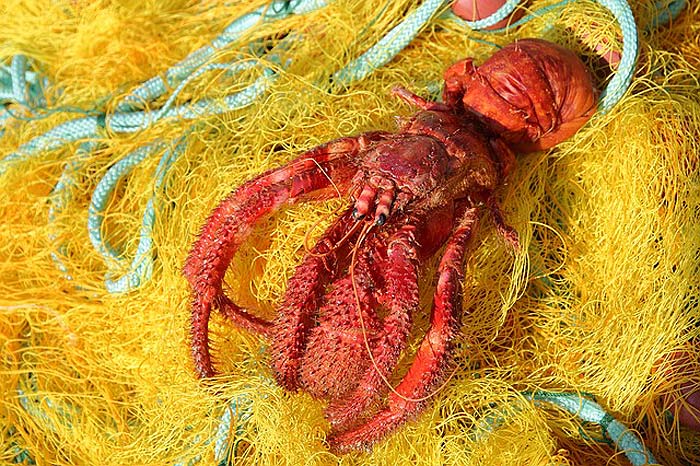
Lobsters have a large number of natural predators who range from mammals to the members of class Pisces and other lobster species.
What Do Lobsters Eat? The Top 8 Foods They Love!
Historically, lobsters were assumed to be mostly scavengers, consuming decaying organic matter. However, lobsters primarily eat fresh food which includes shrimp, sea urchins, plant life, mollusks, and even other lobsters, although rare.
Lobsters are omnivorous and will hunt for food all day long. If there is access to food, they will eat it. In times of need, they can even alter their diet. They prefer to hunt at night and hide from predators during daylight. According to scientists that research lobsters, they are as intelligent as octopuses, which have long been thought of as the world’s most intelligent invertebrate. Let’s dive into the full details on what lobsters eat!
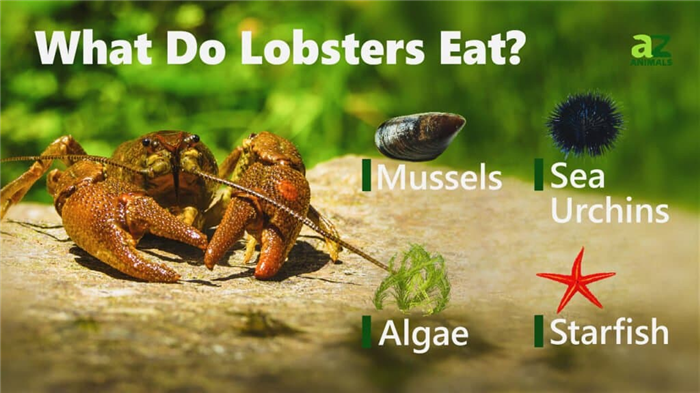
Lobsters eat mussels, urchin, algae, and starfish.
Do Lobster Eating Habits Vary by Species?
The diet of lobsters varies by species. The Spiny Lobster and the Clawed Lobster are the two main types, or families of lobsters. Believe it or not, but there about 60 species of spiny lobsters and more than 50 species of clawed lobsters!
Clawed Lobster
The most famous types of clawed lobsters are the American and European. North Americans are best familiar with the American Lobster, which is collected off the coasts of Maine and other New England states, as well as near Canada’s Atlantic Provinces. European Lobsters are found in the eastern Atlantic Ocean from northern Norway to Morocco and the Azores. They are found in the Mediterranean Sea west of Crete and the Black Sea.
Spiny Lobster
This lobster is a warm-water crustacean. Spiny lobsters are found off the coast of California, near Florida, and in the Caribbean Sea. In fact, they constitute the Bahamas’ largest food export. They are also found near Australia, New Zealand, Papua New Guinea, and other southeast Pacific islands, as well as along the South African coast.
The spiny variant has large antennae for movement detection and is covered with spines to evade predators. These lobsters have five identical legs instead of huge front claws, like the American or European Lobster.
What Do Lobsters Eat?
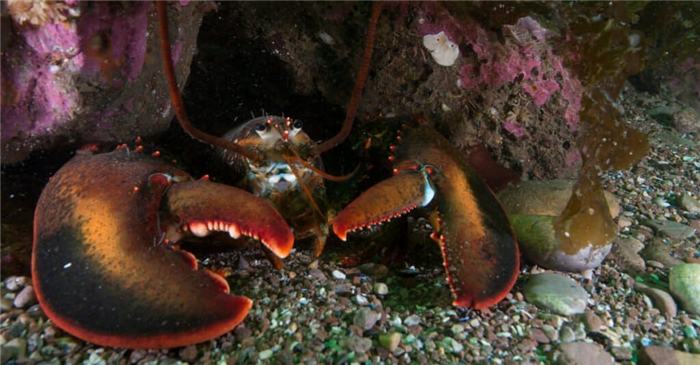
Lobsters will eat anything they can get their claws on, whether dead or alive.
Lobsters eat shrimp, mussels, worms, urchins, carrion, algae, mollusks, and crustaceans. As we noted above, what lobsters eat will depend on the species. We’ll dive into some of their favorite prey below:
Shrimps
Yes, lobsters do eat shrimp. Shrimp are the primary food source for Caribbean furry lobsters.
Worms
Lobsters may eat a wide variety of marine worms, including flatworms, roundworms, arrow worms, and horseshoe worms.
Sea Urchins
Spiny lobsters enjoy consuming sea urchins as a source of nutrition. On the sea floor, many kinds of sea urchins can be discovered, and they will eat all of them!
Carrion Meat
Most lobsters, particularly spiny lobsterz, will feed on carrion meat that they discover drifting around on the bottom or in the water. They’ll consume any meat they can get their claws on.
Algae/Plant life
Both American and European lobsters enjoy algae. Because lobsters live on the seafloor, they can easily feed on algae which grows in abundance there. Algae come in a wide variety, and lobsters consume them all. Some lobsters also eat zooplankton and flowering plants.
Mollusks
Both American and Caribbean spiny lobsters eat mollusks. There are 85,000 mollusk species. Lobsters will devour any of these species that live on seafloor they can find.
Crustaceans
American and spiny lobsters both eat crustaceans. These hard-shelled arthropods are the ones you see on the beach, like prawns, krill, barnacles, and crayfish. Lobsters eat a wide range of sea creatures.
Clawed lobsters like the American and Marine lobsters enjoy eating fish. When hunting, they will sit and wait out little fish as they pass by. The lobster’s claws will catch the fish so fast; they won’t even know what hit them.
How Do Lobsters Find Their Food?
Lobsters frequently hunt for food at night. To find their prey in the dark, Lobster’s “smell” using four little antennae on their heads and detecting hairs all over their bodies. Their smell is so sensitive that they can detect a single amino acid in their favorite foods.
Lobsters eat more as they lose their old shells because they require calcium to rebuild it. A newborn lobster will eat an 8cm jellyfish in four days.
Do Lobsters Eat Other Lobsters?
Lobsters do eat other lobsters. Traditionally this behavior occurs mostly in captivity in conditions where lobsters are placed in confined conditions. However, that may be changing.
Wild lobsters are omnivores, which means they’ll consume about anything they come across in the water or on the ocean floor. In recent experiments where scientists left young lobsters as bait, they were surprised to find that the most common predators of the young lobsters were adult lobsters. We’ve embedded a video of these lobsters exhibiting cannibalism below.
The bottom line is that lobsters will eat other lobster species and even their own young if alternative foods are not accessible to them or if the other lobster is tiny enough to catch and devour. Your lobsters will also eat any other animal in the aquarium, including fish and shellfish.
With lobster populations growing – thanks in part to rising sea temperatures off the coast of Maine and other northerly locations – they’re more likely to see other lobsters as a food source.
Do Lobsters Eat Their Shell?
It is common for lobsters to devour their own shells when they have recently molted. By absorbing water, they battle out of their old shells and grow larger. Lobsters may try to devour their old shells after molting to help harden their new shells faster.
During the first 5-7 years of a lobster’s existence, it sheds its shell approximately 25 times. The hardening of the new shell is accelerated by this replenishment of the calcium that was lost during the removal of the old shell, which takes between 14 and 30 days. As lobsters age, the molting of their shells becomes incredibly energy intensive and eventually older lobsters simply cease molting. Lobsters who have stopped molting begin getting infections in their shells, which is usually the leading cause of death for the world’s oldest lobsters.
How to Feed A Lobster In A Tank
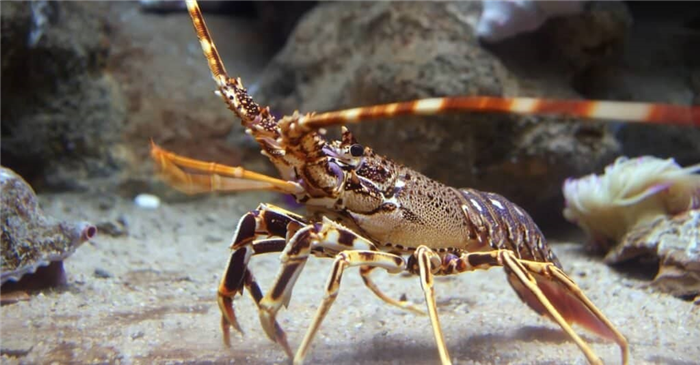
Pet or captive, lobsters eat pellets, shrimp, crabs, and other seafood.
Lobsters in a tank usually eat a combination of live seafood and pellets. In the wild, lobsters eat a wide variety of sea creatures in the wild, including oysters, clams, mussels, fish, and starfish. With the popular tank species of spiny lobster, a combination of pellets and various seafood is necessary to sustain them. You can get vegetation-based pellets at pet stores.
A range of foods such as crabs and shrimp, as well as other seafood, should be included in the diets of captive lobsters to keep them healthy. Because of a lack of natural food and boredom, they are significantly more prone to resort to cannibalism when kept in captivity.
Share this post on:
Jennifer Gaeng
A substantial part of my life has been spent as a writer and artist, with great respect to observing nature with an analytical and metaphysical eye. Upon close investigation, the natural world exposes truths far beyond the obvious. For me, the source of all that we are is embodied in our planet; and the process of writing and creating art around this topic is an attempt to communicate its wonders.
What is the largest lobster ever caught?
The Massachusetts Lobstermen’s Association claimed a record when they caught “Big George” in 1974 off Cape Cod. The lobster weighed 37.4 pounds, with a total length of 2.1 feet.
If a lobster gets into a trap first, crabs would not enter the “parlor” or holding section. This is because if a crab starts up the entry to the parlor, the lobster will make aggressive displays which make the crab back down. Crabs do not keep other crabs out, nor lobsters, so if a crab got in first, lobsters would still come in. In general, crabs are less aggressive than lobsters.
